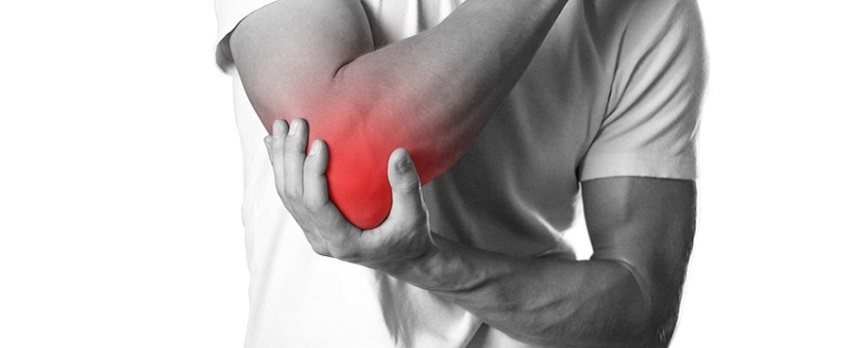The elbow is a complex joint, and pain in that area is one of the more common issues our Toronto physiotherapy and sports medicine professionals treat on an ongoing basis.
It's where the three bones of the arm meet, cushioned by cartilage, and held together with ligaments. These are contained within the joint capsule. The tendons hold the muscle to the bone, and nerves and blood vessels run through the entire arm.

Symptoms May Vary
Because there are various types of tissue, the symptoms may vary to a certain extent. Problems at the elbow joint generally mean:
- Soreness or pain;
- Decreased range of motion;
- Tingling from the elbow down to the fingers.
In some cases, there may be be nausea. Pay attention to when you feel the discomfort – when the joint is straight, bent, or both?
Here’s a look at the more common causes of elbow pain and discomfort.
Tendinitis
Tendons can become inflamed for various reasons, including sudden injuries, repetitive motion, and over-use over time. Symptoms include pain and tenderness. Prevention is the best approach to tendinitis.
- Proper warm-ups before exercise;
- Correct form in practising a sport or activity;
- Toning and building muscle to support the joints.
Arthritis
Arthritis is a range of diseases that affect the joints, causing swelling, pain, stiffness and reduced range of motion. Osteoarthritis is one of the most common types.
- Along with other treatment options, exercise is crucial for patients with arthritis;
- It increases flexibility and strength as it decreases pain and stiffness.
Bursitis
Where the muscle and tendon meets the bone, there is a sac filled with fluid called bursa, which acts as a lubricant and cushion. When the bursae are inflamed, it is called bursitis, and symptoms include pain and stiffness.
- Exercises that strengthen the muscles of the hip and leg are your best prevention against developing bursitis;
- Even if you have already developed it, a targeted exercise program developed by your Toronto physiotherapist or other sports medicine specialist can help ease the pain;
- Stretching and proper warm-ups are also important.
Tennis Elbow
You don’t need to play tennis to get tennis elbow, or lateral epicondylitis. It is usually the result of activities that involve repeated motions that rotate the wrist – such as playing tennis, golfing, or swimming. Symptoms begin with mild pain that becomes worse over time, radiating from the outside of the elbow to the forearm. Pain will increase when shaking or squeezing and object.
- Exercises that strengthen and stretch the structures of the wrist and forearm can help to minimize the risk;
- Use proper form when practising your sport;
- Avoid over-using the muscles of the elbow.
Cubital Tunnel Syndrome
The ulnar nerve runs from the neck to the tips of the last two fingers. When it becomes either overly stretched or compressed, it results in cubital tunnel syndrome. The symptoms include sharp pains, weakness, and tingling that extends from the elbow to the last two fingers.
- Prevention typically means avoidance – avoiding extended activities where the elbow is bent;
- Good ergonomics will reduce the risk – avoid sitting at a desk with the chair too low.
- Avoid leaning on the elbow;
- Sleep with your arms in a straight position as much as you can.
Pain in the elbow, or any joint, that persists over time isn’t something you can ignore. Our Toronto physiotherapists and chiropractors are available to answer your questions and start you on the road to effective treatment. Don’t hesitate to contact us today.















